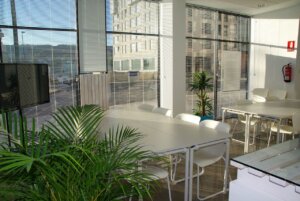
How to Incorporate Sustainable Office Practices Across Industries
While things are changing, today’s office practices still miss the mark on sustainability. From the glaring waste of paper to single-use plastics, lights left on, and electronic devices humming away even when not in use – they all add up. And that’s just scratching the surface. There’s more beneath this iceberg of inefficiency and waste.
But, with a little bit of effort, we can create an office that truly aligns with eco-friendly values – one where resources are optimized and processes respect both your bottom line and Mother Nature’s patience.
That’s our scope for today’s article: we’ll have a look at green practices (that we know work) for offices across various industries that anyone can adopt.
Circular Economy Principles in the Workplace
Most offices practice a linear cycle of use-and-dispose. In contrast, the circular economy aims to eliminate waste and maximize resource use by finding a different use for discarded objects and materials.
You can start with simple changes like switching to recycled or sustainably sourced paper, implementing double-sided printing policies, or investing in modular furniture that’s easily repairable.
Participate in programs to refill or recycle printer cartridges instead of discarding them. On a similar note, rechargeable batteries should be used over single-use options. For the kitchen area, provide reusable utensils, cups, and plates to reduce single-use plastics.
If you want to offer your employees customized office items, like notebooks, water bottles, awards, or paperweights, work with a company known for its sustainable practices or uses sustainable materials.
For instance, custom crystal paperweight designs are more environmentally friendly than ones made from plastic materials.
Bring Nature Indoors to Boost Productivity
The biophilic design taps into our innate connection with nature, infusing office spaces with natural elements, such as natural light, organic materials, views of greenery, and even water elements.
This approach enhances well-being and productivity because natural elements create a soothing environment that reduces stress levels. Lower stress translates into better focus and efficiency.
Consider how an office with abundant natural light can improve mood compared to one with harsh artificial lighting. Exposure to nature-inspired settings enhances creativity by providing visual breaks from the monotony of screens and walls.
These spaces also promote well-being by improving air quality through plants, which can lead to fewer sick days. Employees working in such environments typically report feeling more energized and satisfied, leading to higher morale.
Green Certifications for Modern Offices
Did you know you can obtain a green certification for your office? These certifications recognize and validate your commitment to sustainability through adherence to established environmental standards.
Furthermore, going for a green certification can boost your office’s commitment to sustainability from lip service to a recognized standard. They also make it easier to implement sustainable practices as you get guidelines and benchmarks.
Think of these certifications as the office equivalent of a nutritional label on food. They offer clarity and assurance, allowing you to track improvements over time.
For instance, LEED (Leadership in Energy and Environmental Design) is one widely respected program. It assesses energy use, waste management, water conservation, and indoor environmental quality.
Certifications often motivate teams by setting achievable goals within an existing framework. Your office might pursue something like ENERGY STAR for appliances or WELL certification for health-focused workspaces.
Wrap Up
The future of office design centers on sustainability, blending innovation with environmental responsibility.
As your company continues to embrace eco-friendly practices, your office(s) will continue to evolve into a space that prioritizes health and efficiency. As a result, your employees will feel more productive and happier to work in such an environment.
By integrating these elements today, you’re setting a standard for tomorrow’s workplaces, where we find the balance between productivity and ecological responsibility.